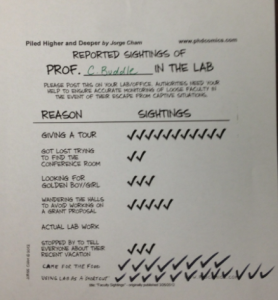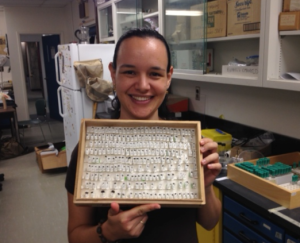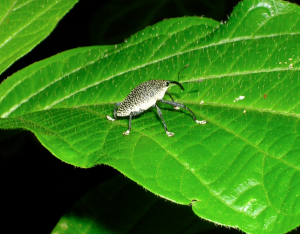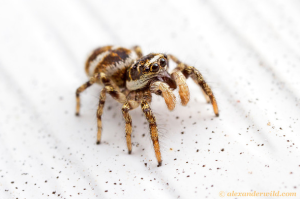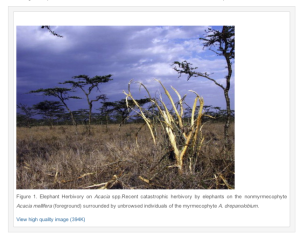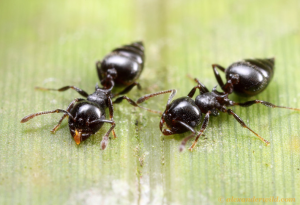Nalini Nadkarni visited McGill University, and my laboratory, last week. This event was hosted by the McGill School of Environment (their annual public lecture). Nalini Nadkarni is a superb canopy biologist, and I’ve known about her research for a long time. She has also done a TED talk (wow!). Her visit was a delight - and I was honoured to be able to introduce her public lecture and have dinner with her and a few other guests. Here’s a photo to prove it!

Nalini Nadkarni & Chris Buddle
I learned a great deal from Nalini Nadkarni - she is one of those amazing people who is able to “do more” and this is inspiring. She has her scientific credentials, but is also able to take her scientific expertise to non-traditional audiences (e.g., prisoners, church-goers, inner-city kids, musicians, artists). This is what defines scientific outreach.
Nalini Nadkarni leads by example, and the message is clear: Scientists should do outreach activities (it might be argued that scientists have a responsibility to do more outreach). This is a significant challenge, in part because academic structures do not typically reward such activities - the world of academia often focuses on research productivity (i.e., publications!). However, there are ways to do outreach, and just because academic structures may not be conducive to outreach activities, it’s still an important activity, as The Bug Geek blogs about in this excellent post: http://thebuggeek.com/2012/03/12/science-outreach-may-not-be-a-useful-currency-for-grad-students-but-we-should-do-it-anyway/.
I wish to focus on something a little different here - more specifically about some characteristics of scientists that place them in a particularly strong position to do effective outreach. These ideas are in part drawn from Nalini Nadkarni’s lecture and on discussions with her, but are also some of my own opinions and ideas (and, as usual, I’m biased by my experiences in the disciplines of ecology, entomology, and biology).
1. Scientists have specialized, interesting expertise. Most of the scientists that I know have very specialized, and fascinating knowledge at their fingertips, honed and developed over years of experience. I would also argue that many scientists don’t realize that their expertise is interesting to a non-traditional audience. For example, I never felt that anyone would really care about the generalized life cycle of an orb-web spider, but I have found that most general audiences are hungry for specialized (aka WEIRD!) knowledge from an ‘expert’ in a particular area.
2. Scientists have credentials. Most working scientists have gone through some rigorous training to get to where they are. It may not necessarily be a MSc or PhD, but more than likely, scientists have a minimum of a B.Sc. degree - this qualifies as advanced training - and with this kind of degree comes credibility. This is a huge payoff from a University education. (by the way, with outreach activities, nobody cares about your transcript, so it’s one place where it doesn’t matter if you barely passed physics - yes, this example is something I have direct experience with)
3. Scientists are critical thinkers (and sceptics). This may seem odd in this list, but a healthy dose of scepticism is important for outreach activities. Most outreach activities, regardless of the audience, will end up with the ‘scientist’ being asked for opinions on various topics that are circulating in the media and on-line. Thankfully, most scientists are trained to be critical thinkers. As we know there is a lot of mis-information out there, and a critical thinker is in a strong position to drill down to the right topics and correct facts.
4. Scientists are communicators. Scientists are typically good communicators in one form or another. In the world of science, your work is only as strong as your ability to communicate it effectively, whether it be for a grant application, scientific publication, teaching, or an oral presentation for a job interview. Communication skills are continually honed during the career of a scientists, and these skills are perfectly suited for outreach. Although the audience is different, the fundamentals remain the same.
5. Scientists are passionate. Scientists are naturally curious, and often continue to have a child-like enthusiasm for their chosen specialty. Passion is not a trainable skill. It’s not something to learn from reading. Passion comes from deep within, and is a wonderful gift to be shared, and it is perfectly suited to outreach activities.
Are you now convinced to search out opportunities to do some outreach activities? How to proceed?
Nalini Nadkarni argues that outreach opportunities are everywhere, whether it’s talking to the person next to you on an airplane, writing a blog post, or delivering a talk about insects to a garden club. Even the small, seemingly insignificant outreach opportunities can change perspectives, and inspire others, and do a lot of good. Just have a look at the sustainable prisons project that resulted from Nalini Nadkarni’s outreach activities with prisons (which started as a small, albeit clever, idea): http://blogs.evergreen.edu/sustainableprisons/. Find a little time to take advantage of these opportunities. Outreach does not need to be time consuming, or stressful. Look at it as an enjoyable and rewarding way to bring your science to more people.
By the way, Nalini Nadkarni’s public lecture was tremendous, and thankfully, was live-tweeted, avaiable on Storify: http://storify.com/GeekInQuestion/nalini-nadkarni-talk-at-mcgill-university. (thanks to The Bug Geek for doing this!)
To finish, my laboratory benefited from our interactions with a generous, well-spoken, intelligent and inspirational scientist. Thanks to Nalini Nadkarni for spending time with us.

Our laboratory, visiting with Nalini Nadkarni. (l to r, Chris, Sarah, Crystal, Katie, Nalini, Laura, Dorothy, Raphael)
